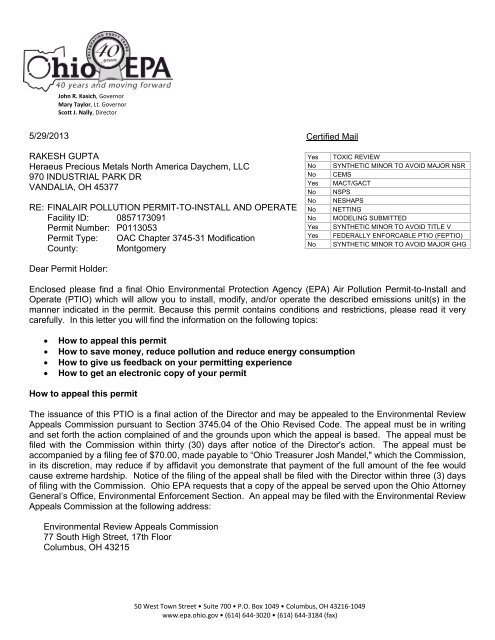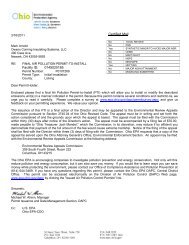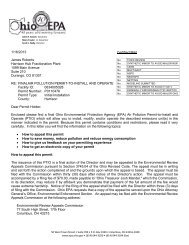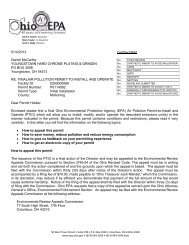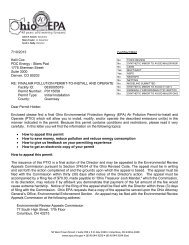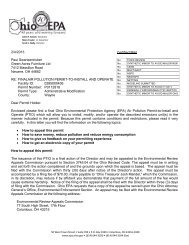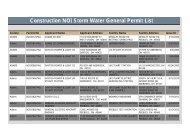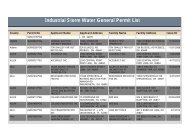5/29/2013 RAKESH GUPTA Heraeus Precious ... - State of Ohio
5/29/2013 RAKESH GUPTA Heraeus Precious ... - State of Ohio
5/29/2013 RAKESH GUPTA Heraeus Precious ... - State of Ohio
Create successful ePaper yourself
Turn your PDF publications into a flip-book with our unique Google optimized e-Paper software.
Authorization (continued)Final Permit-to-Install and Operate<strong>Heraeus</strong> <strong>Precious</strong> Metals North America Daychem, LLCPermit Number: P0113053Facility ID: 0857173091Effective Date: 5/<strong>29</strong>/<strong>2013</strong>Permit Number: P0113053Permit Description: Chapter 31 modification to transition from minor source to synthetic minor source forhazardous air pollutants.Permits for the following Emissions Unit(s) or groups <strong>of</strong> Emissions Units are in this document as indicatedbelow:Emissions Unit ID:Company Equipment ID:Superseded Permit Number:General Permit Category and Type:P001300 gallon process mix tankP0107491Not ApplicablePage 2 <strong>of</strong> 21
Final Permit-to-Install and Operate<strong>Heraeus</strong> <strong>Precious</strong> Metals North America Daychem, LLCPermit Number: P0113053Facility ID: 0857173091Effective Date: 5/<strong>29</strong>/<strong>2013</strong>A. Standard Terms and ConditionsPage 3 <strong>of</strong> 21
Final Permit-to-Install and Operate<strong>Heraeus</strong> <strong>Precious</strong> Metals North America Daychem, LLCPermit Number: P0113053Facility ID: 0857173091Effective Date: 5/<strong>29</strong>/<strong>2013</strong>1. What does this permit-to-install and operate ("PTIO") allow me to do?This permit allows you to install and operate the emissions unit(s) identified in this PTIO. You mustinstall and operate the unit(s) in accordance with the application you submitted and all the terms andconditions contained in this PTIO, including emission limits and those terms that ensure compliancewith the emission limits (for example, operating, recordkeeping and monitoring requirements).2. Who is responsible for complying with this permit?The person identified on the "Authorization" page, above, is responsible for complying with this permituntil the permit is revoked, terminated, or transferred. "Person" means a person, firm, corporation,association, or partnership. The words "you," "your," or "permittee" refer to the "person" identified onthe "Authorization" page above.The permit applies only to the emissions unit(s) identified in the permit. If you install or modify any otherequipment that requires an air permit, you must apply for an additional PTIO(s) for these sources.3. What records must I keep under this permit?You must keep all records required by this permit, including monitoring data, test results, strip-chartrecordings, calibration data, maintenance records, and any other record required by this permit for fiveyears from the date the record was created. You can keep these records electronically, provided theycan be made available to <strong>Ohio</strong> EPA during an inspection at the facility. Failure to make requestedrecords available to <strong>Ohio</strong> EPA upon request is a violation <strong>of</strong> this permit requirement.4. What are my permit fees and when do I pay them?There are two fees associated with permitted air contaminant sources in <strong>Ohio</strong>:PTIO fee. This one-time fee is based on a fee schedule in accordance with <strong>Ohio</strong> Revised Code (ORC)section 3745.11, or based on a time and materials charge for permit application review and permitprocessing if required by the Director.You will be sent an invoice for this fee after you receive this PTIO and payment is due within 30 days <strong>of</strong>the invoice date. You are required to pay the fee for this PTIO even if you do not install or modify youroperations as authorized by this permit.Annual emissions fee. <strong>Ohio</strong> EPA will assess a separate fee based on the total annual emissions fromyour facility. You self-report your emissions in accordance with <strong>Ohio</strong> Administrative Code (OAC)Chapter 3745-78. This fee assessed is based on a fee schedule in ORC section 3745.11 and funds<strong>Ohio</strong> EPA’s permit compliance oversight activities. Unless otherwise specified, facilities subject to oneor more synthetic minor restrictions must use <strong>Ohio</strong> EPA's "Air Services" to submit annual emissionsassociated with this permit requirement.<strong>Ohio</strong> EPA will notify you when it is time to report your emissionsand to pay your annual emission fees.5. When does my PTIO expire, and when do I need to submit my renewal application?This permit expires on the date identified at the beginning <strong>of</strong> this permit document (see "Authorization"page above) and you must submit a renewal application to renew the permit. <strong>Ohio</strong> EPA will send arenewal notice to you approximately six months prior to the expiration date <strong>of</strong> this permit. However, it isPage 4 <strong>of</strong> 21
Final Permit-to-Install and Operate<strong>Heraeus</strong> <strong>Precious</strong> Metals North America Daychem, LLCPermit Number: P0113053Facility ID: 0857173091Effective Date: 5/<strong>29</strong>/<strong>2013</strong>10. Do I have to report malfunctions <strong>of</strong> emissions units or air pollution control equipment? If so,how must I report?If you have a reportable malfunction <strong>of</strong> any emissions unit(s) or any associated air pollution controlsystem, you must report this to the Regional Air Pollution Control Agency in accordance with OAC rule3745-15-06(B). Malfunctions that must be reported are those that result in emissions that exceedpermitted emission levels. It is your responsibility to evaluate control equipment breakdowns andoperational upsets to determine if a reportable malfunction has occurred.If you have a malfunction, but determine that it is not a reportable malfunction under OAC rule 3745-15-06(B), it is recommended that you maintain records associated with control equipment breakdown orprocess upsets. Although it is not a requirement <strong>of</strong> this permit, <strong>Ohio</strong> EPA recommends that youmaintain records for non-reportable malfunctions.11. Can <strong>Ohio</strong> EPA or my local air agency inspect the facility where the emission unit(s) is/arelocated?Yes. Under <strong>Ohio</strong> law, the Director or his authorized representative may inspect the facility, conducttests, examine records or reports to determine compliance with air pollution laws and regulations andthe terms and conditions <strong>of</strong> this permit. You must provide, within a reasonable time, any information<strong>Ohio</strong> EPA requests either verbally or in writing.12. What happens if one or more emissions units operated under this permit is/are shut downpermanently?<strong>Ohio</strong> EPA can terminate the permit terms associated with any permanently shut down emissions unit."Shut down" means the emissions unit has been physically removed from service or has been alteredin such a way that it can no longer operate without a subsequent "modification" or "installation" asdefined in OAC Chapter 3745-31.You should notify <strong>Ohio</strong> EPA <strong>of</strong> any emissions unit that is permanently shut down by submitting 1 acertification that identifies the date on which the emissions unit was permanently shut down. Thecertification must be submitted by an authorized <strong>of</strong>ficial from the facility. You cannot continue to operatean emissions unit once the certification has been submitted to <strong>Ohio</strong> EPA by the authorized <strong>of</strong>ficial.You must comply with all recordkeeping and reporting for any permanently shut down emissions unit inaccordance with the provisions <strong>of</strong> the permit, regulations or laws that were enforceable during theperiod <strong>of</strong> operation, such as the requirement to submit a PER, air fee emission report, or malfunctionreport. You must also keep all records relating to any permanently shutdown emissions unit, generatedwhile the emissions unit was in operation, for at least five years from the date the record wasgenerated.Again, you cannot resume operation <strong>of</strong> any emissions unit certified by the authorized <strong>of</strong>ficial as beingpermanently shut down without first applying for and obtaining a permit pursuant to OAC Chapter 3745-31.1 Permittees that use <strong>Ohio</strong> EPA's "Air Services" can mark the affected emissions unit(s) as "permanently shutdown" in thefacility pr<strong>of</strong>ile along with the date the emissions unit(s) was permanently removed and/or disabled. Submitting thefacility pr<strong>of</strong>ile update will constitute notifying <strong>of</strong> the permanent shutdown <strong>of</strong> the affected emissions unit(s).Page 6 <strong>of</strong> 21
13. Can I transfer this permit to a new owner or operator?Final Permit-to-Install and Operate<strong>Heraeus</strong> <strong>Precious</strong> Metals North America Daychem, LLCPermit Number: P0113053Facility ID: 0857173091Effective Date: 5/<strong>29</strong>/<strong>2013</strong>You can transfer this permit to a new owner or operator. If you transfer the permit, you must follow theprocedures in OAC Chapter 3745-31, including notifying <strong>Ohio</strong> EPA or the local air agency <strong>of</strong> thechange in ownership or operator. Any transferee <strong>of</strong> this permit must assume the responsibilities <strong>of</strong> thetransferor permit holder.14. Does compliance with this permit constitute compliance with OAC rule 3745-15-07, "air pollutionnuisance"?This permit and OAC rule 3745-15-07 prohibit operation <strong>of</strong> the air contaminant source(s) regulatedunder this permit in a manner that causes a nuisance. <strong>Ohio</strong> EPA can require additional controls ormodification <strong>of</strong> the requirements <strong>of</strong> this permit through enforcement orders or judicial enforcementaction if, upon investigation, <strong>Ohio</strong> EPA determines existing operations are causing a nuisance.15. What happens if a portion <strong>of</strong> this permit is determined to be invalid?If a portion <strong>of</strong> this permit is determined to be invalid, the remainder <strong>of</strong> the terms and conditions remainvalid and enforceable. The exception is where the enforceability <strong>of</strong> terms and conditions are dependenton the term or condition that was declared invalid.Page 7 <strong>of</strong> 21
Final Permit-to-Install and Operate<strong>Heraeus</strong> <strong>Precious</strong> Metals North America Daychem, LLCPermit Number: P0113053Facility ID: 0857173091Effective Date: 5/<strong>29</strong>/<strong>2013</strong>B. Facility-Wide Terms and ConditionsPage 8 <strong>of</strong> 21
Final Permit-to-Install and Operate<strong>Heraeus</strong> <strong>Precious</strong> Metals North America Daychem, LLCPermit Number: P0113053Facility ID: 0857173091Effective Date: 5/<strong>29</strong>/<strong>2013</strong>1. This permit document constitutes a permit-to-install issued in accordance with ORC 3704.03(F) and apermit-to-operate issued in accordance with ORC 3704.03(G).a) For the purpose <strong>of</strong> a permit-to-install document, the facility-wide terms and conditions identifiedbelow are federally enforceable with the exception <strong>of</strong> those listed below which are enforceableunder state law only.(1) None.b) For the purpose <strong>of</strong> a permit-to-operate document, the facility-wide terms and conditionsidentified below are enforceable under state law only with the exception <strong>of</strong> those listed belowwhich are federally enforceable.(1) None.2. Synthetic Minor HAP Limitations:a) The hazardous air pollutant (HAP) emissions from emissions units P001 and P008 shall notexceed 5.68 tons for any individual HAP on a rolling 12-month basis and 8.44 tons for anycombination <strong>of</strong> HAPs on a rolling 12-month basis.b) The permittee shall not process more than 40 batches <strong>of</strong> products containing methylenechloride in emissions units P001 and P008, combined, on a rolling 12-month basis.c) The permittee shall keep records each month <strong>of</strong> the following information for emissions unitsP001 and P008:(1) The solvent composition <strong>of</strong> each product manufactured;(2) The volume, in number <strong>of</strong> batches, <strong>of</strong> each product manufactured;(3) The individual HAP (i.e., methylene chloride) emissions, in pounds or tons, calculated bymultiplying the emission factor, in pounds <strong>of</strong> individual HAP per batch, by the quantity <strong>of</strong>batches manufactured for each product.(4) The individual HAP emissions factor will be calculated by:a. determining the partial pressure for each individual HAP, in mm Hg, according toEquation 2.6 <strong>of</strong> the EPA Air Pollution Control Cost Manual (EPA/452/B-02-001,January 2002, Section 3.1, Chapter 2);.b. using the partial pressure for each individual HAP into an outlet concentration, inparts per million, by dividing the partial pressure from 2.c)(4)a. by 760 mm Hg;c. converting the concentration, in parts per million to milligrams per cubic meter, bymultiplying the concentration from 2.c)(4)b. by the molecular weight <strong>of</strong> thecompound and dividing by 24.45 liters (molar volume <strong>of</strong> air);d. determine the individual HAP emissions rate in milligams per hour by multiplyingthe concentration in milligrams per cubic meter from 2.c)(4)c. by the exhaust flowrate from the condenser in cubic meters per hour;Page 9 <strong>of</strong> 21
Final Permit-to-Install and Operate<strong>Heraeus</strong> <strong>Precious</strong> Metals North America Daychem, LLCPermit Number: P0113053Facility ID: 0857173091Effective Date: 5/<strong>29</strong>/<strong>2013</strong>e. convert the individual HAP emissions rate to pounds per hour by multiplying theVOC emissions rate in milligrams per hour from 2.c)(4)d. by 454,000 milligramsper pound;f. determine the individual HAP emissions rate, in pounds per batch by multiplyingthe VOC emissions rate, in pounds per batch, by multiplying the individual HAPemissions rate, in pounds per hour, by the length <strong>of</strong> time, in hours, that individualHAP emissions are vented from the reflux condenser.(5) The rolling-12 month individual HAP emissions rate, the sum <strong>of</strong> the individual HAPemissions rates from the 2.c)(3) for the previous 12-months.(6) The combined HAP emissions rate, in pounds or tons, the sum <strong>of</strong> all the individual HAPemissions from 2.c)(3) for all HAPs combined.(7) The rolling-12 month combined HAP emissions rate, the sum <strong>of</strong> the combined HAPsemissions rates from the 2.c)(6) for the previous 12-months.d) The permittee shall submit quarterly deviation (excursion) reports that identify:(1) all deviations (excursions) <strong>of</strong> the following emission limitations and operationalrestrictions detected by the monitoring, record keeping and/or testing requirements inthis permit:a. the rolling 12-month individual HAP emissions limitation;b. the rolling 12-month combined HAP emissions limitation; andc. the rolling 12-month methylene chloride processing limitation.d. the probable cause <strong>of</strong> each deviation (excursion);e. any corrective actions that were taken to remedy the deviations (excursions) orprevent future deviations (excursions); andf. the magnitude and duration <strong>of</strong> each deviation (excursion).If no deviations (excursions) occurred during a calendar quarter, the permittee shallsubmit a report that states that no deviations (excursions) occurred during the quarter.The quarterly reports shall be submitted, electronically through <strong>Ohio</strong> EPA Air Services,each year by January 31 (covering October to December), April 30 (covering January toMarch), July 31 (covering April to June), and October 31 (covering July to September),unless an alternative schedule has been established and approved by the Director (theappropriate District Office or local air agency).Page 10 <strong>of</strong> 21
Final Permit-to-Install and Operate<strong>Heraeus</strong> <strong>Precious</strong> Metals North America Daychem, LLCPermit Number: P0113053Facility ID: 0857173091Effective Date: 5/<strong>29</strong>/<strong>2013</strong>e) Compliance with the Emissions Limitations specified in 2.a) shall be determined in accordancewith the following methods:(1) Emissions Limitation –The individual HAP emissions from emissions units P001 and P008 shall not exceed5.68 tons on a rolling 12-month basis.Applicable Compliance Method –Compliance shall be based on the record keeping requirements <strong>of</strong> 2.c) and the sum <strong>of</strong>the monthly individual HAP emissions rates for the previous 12-months.(2) Emissions Limitation –The combined HAP emissions from P001 and P008 shall not exceed 8.44 tons on arolling 12-month basis.Applicable Compliance Method –Compliance shall be based on the record keeping requirements <strong>of</strong> 2.c) and the sum <strong>of</strong>all the combined HAP emissions rates for the previous 12-months.(3) Emissions Limitation –The permittee shall not process more than 40 batches <strong>of</strong> methylene chlorideformulations in emissions units P001 and P008, combined, on a rolling 12-month basis.Applicable Compliance Method –Compliance shall be based on the record keeping requirements <strong>of</strong> 2.c) and the sum <strong>of</strong>all the methylene chloride batches for the previous 12-months.3. The <strong>Ohio</strong> EPA has determined that this facility is subject to the requirements <strong>of</strong> 40 CFR part 63 SubpartVVVVVV, National Emissions Standards for Hazardous Air Pollutants: Area Source Standards forChemical Manufacturing. Although <strong>Ohio</strong> EPA has determined that this area source MACT (also knownas the GACT) applies, at this time <strong>Ohio</strong> EPA does not have the authority to enforce this standard.Instead, U.S. EPA has the authority to enforce this standard. Please be advised, that all requirementsassociated with this rule are in effect and shall be enforced by U.S. EPA.Page 11 <strong>of</strong> 21
Final Permit-to-Install and Operate<strong>Heraeus</strong> <strong>Precious</strong> Metals North America Daychem, LLCPermit Number: P0113053Facility ID: 0857173091Effective Date: 5/<strong>29</strong>/<strong>2013</strong>C. Emissions Unit Terms and ConditionsPage 12 <strong>of</strong> 21
Final Permit-to-Install and Operate<strong>Heraeus</strong> <strong>Precious</strong> Metals North America Daychem, LLCPermit Number: P0113053Facility ID: 0857173091Effective Date: 5/<strong>29</strong>/<strong>2013</strong>1. P001, 300 gallon process mix tankOperations, Property and/or Equipment Description:300 gallon process mix tanka) This permit document constitutes a permit-to-install issued in accordance with ORC 3704.03(F)and a permit-to-operate issued in accordance with ORC 3704.03(G).(1) For the purpose <strong>of</strong> a permit-to-install document, the emissions unit terms and conditionsidentified below are federally enforceable with the exception <strong>of</strong> those listed below whichare enforceable under state law only.a. b)(1)b. and b)(1)d.(2) For the purpose <strong>of</strong> a permit-to-operate document, the emissions unit terms andconditions identified below are enforceable under state law only with the exception <strong>of</strong>those listed below which are federally enforceable.a. b)(1)c.b) Applicable Emissions Limitations and/or Control Requirements(1) The specific operation(s), property, and/or equipment that constitute each emissions unitalong with the applicable rules and/or requirements and with the applicable emissionslimitations and/or control measures are identified below. Emissions from each unit shallnot exceed the listed limitations, and the listed control measures shall be specified innarrative form following the table.Applicable Rules/Requirementsa. OAC rule 3745-31-05(A)(3)As effective 11/30/01b. OAC rule 3745-31-05(A)(3)(a)(ii)As effective 12/01/06c. OAC rule 3745-31-05(D)(synthetic minor to avoid Title V)d. ORC rule 3745-114 and ORC3704.03(F)Applicable Emissions Limitations/ControlMeasuresThe organic compound (OC) emissionsfrom this emissions unit shall not exceed285 pounds per batch and 14.8 tons peryear.See b)(2)a., b)(2)b., and b)(2)c.See b)(2)a. and b)(2)d.See Section B.2., b)(2)a., b)(2)e. andc)(1).See d)(6) through d)(9) and e)(3).(2) Additional Terms and Conditionsa. The vents on this emissions unit remain closed during most periods <strong>of</strong> operation.When the vents on this emissions unit are open they exhaust through a chilledwater condenser operated as a reflux condenser with the primary purpose <strong>of</strong>Page 13 <strong>of</strong> 21
Final Permit-to-Install and Operate<strong>Heraeus</strong> <strong>Precious</strong> Metals North America Daychem, LLCPermit Number: P0113053Facility ID: 0857173091Effective Date: 5/<strong>29</strong>/<strong>2013</strong>capturing and condensing any solvent that is evolved and returning it to thereaction. The solvent reflux serves a vital role by controlling such parameters asreaction time and temperature. The reflux condensers predominantly function toregulate and control the physical and chemical reaction that takes place in theaffected equipment.b. The OC emissions limitations for this emissions unit were established to reflectthe potential to emit for this emissions unit. Therefore, it is not necessary toestablish monitoring or record keeping for these emissions limitations. Thisemissions unit employs a variety <strong>of</strong> OC (including but not limited to acetone, ethylacetate, and methylene chloride) that are not defined as volatile organiccompounds (VOC) and VOC (including but not limited to methanol, heptane andacetonitrile). The hourly and annual emissions limitations are based onmethylene chloride (highest vapor pressure for any OC or VOC) as the worstcase for air emissions.c. The permittee has satisfied the Best Available Technology (BAT) requirementspursuant to <strong>Ohio</strong> Administrative Code (OAC) paragraph 3745-31-05(A)(3), aseffective November 30, 2001, in this permit. On December 1, 2006, paragraph(A)(3) <strong>of</strong> OAC rule 3745-31-05 was revised to conform to the <strong>Ohio</strong> Revised Code(ORC) changes effective August 3, 2006 (Senate Bill 265 changes), such thatBAT is no longer required by <strong>State</strong> regulations for National Ambient Air QualityStandards (NAAQS) pollutant(s) less than ten tons per year. However, that rulerevision has not yet been approved by U.S. EPA as a revision to <strong>Ohio</strong>’s <strong>State</strong>Implementation Plan (SIP). Therefore, until the SIP revision occurs and the U.S.EPA approves the revisions to OAC rule 3745-31-05, the requirement to satisfyBAT still exists as part <strong>of</strong> the federally-approved SIP for <strong>Ohio</strong>.Once U.S. EPA approves the December 1, 2006 version <strong>of</strong> OAC rule 3745-31-05, then these emission limitations/control measures no longer apply.d. The BAT requirements under OAC rule 3745-31-05(A)(3) do not apply to theVOC emissions from this air contaminant source because the uncontrolledpotential to emit for VOC is less than 10 tons/year.This rule paragraph applies once U.S. EPA approves the December 1, 2006version <strong>of</strong> OAC rule 3745-31-05 as part <strong>of</strong> the <strong>State</strong> Implementation Plan.e. The hazardous air pollutant (HAP) emissions from emissions units P001 andP008 shall not exceed 5.68 tons for any individual HAP on a rolling 12-monthbasis and 8.44 tons for any combination <strong>of</strong> HAPs on a rolling 12-month basis.c) Operational RestrictionsThe record keeping, reporting and testing requirements necessary to comply withthe synthetic minor HAP emissions limitations are identified in Section B.2. <strong>of</strong> thispermit.(1) The permittee shall not process more than 40 batches <strong>of</strong> products containing methylenechloride in emissions units P001 and P008, combined, on a rolling 12-month basis.Page 14 <strong>of</strong> 21
d) Monitoring and/or Recordkeeping RequirementsFinal Permit-to-Install and Operate<strong>Heraeus</strong> <strong>Precious</strong> Metals North America Daychem, LLCPermit Number: P0113053Facility ID: 0857173091Effective Date: 5/<strong>29</strong>/<strong>2013</strong>(1) The permittee shall maintain the following monthly records for all chemicalsmanufactured in this emissions unit:a. The identification <strong>of</strong> each product manufactured;b. The solvent composition <strong>of</strong> each product manufactured and;c. The number <strong>of</strong> batches, <strong>of</strong> each product manufactured.(2) The permittee shall collect and record the following information for the purpose <strong>of</strong>determining annual OC emissions as required for the Synthetic Minor Title V FeeEmissions Report (SMTV FER). The OC emissions shall be determine according to thefollowing procedures:a. The OC emissions, in pounds or tons, calculated by multiplying the emissionfactor, in pounds <strong>of</strong> OC per batch, by the quantity <strong>of</strong> batches manufactured foreach product.The OC emissions factor will be calculated by:i. determining the partial pressure for each OC, in mm Hg, according toEquation 2.6 <strong>of</strong> the EPA Air Pollution Control Cost Manual (EPA/452/B-02-001, January 2002, Section 3.1, Chapter 2);.ii.iii.iv.using the partial pressure for each OC into an outlet concentration, inparts per million, by dividing the partial pressure from d)(1)d.i. by 760 mmHg;converting the concentration, in parts per million to milligrams per cubicmeter, by multiplying the concentration from d)(1)d.iii. by the molecularweight <strong>of</strong> the compound and dividing by 24.45 liters (molar volume <strong>of</strong> air);determine the OC emissions rate in milligams per hour by multiplying theconcentration in milligrams per cubic meter from d)(1)d.iii. by the exhaustflow rate from the condenser in cubic meters per hour;v. convert the OC emissions rate to pounds per hour by multiplying the OCemissions rate in milligrams per hour from d)(1)d.iv. by 454,000milligrams per pound;vi.determine the OC emissions rate, in pounds per batch by multiplying theOC emissions rate, in pounds per batch, by multiplying the OC emissionsrate, in pounds per hour, by the length <strong>of</strong> time, in hours, that OCemissions are vented from the reflux condenser.(3) In order to maintain compliance with the applicable emission limitations contained in thispermit, the average temperature <strong>of</strong> the exhaust gases from the condenser, for any 3-hour block <strong>of</strong> time, shall not be higher than 85 degrees Fahrenheit.Page 15 <strong>of</strong> 21
Final Permit-to-Install and Operate<strong>Heraeus</strong> <strong>Precious</strong> Metals North America Daychem, LLCPermit Number: P0113053Facility ID: 0857173091Effective Date: 5/<strong>29</strong>/<strong>2013</strong>(4) The permittee shall properly install, operate, and maintain a continuous temperaturemonitor and recorder which measures and records the temperature <strong>of</strong> the exhaust gasesfrom the condenser when the emissions unit(s) is/are in operation, including periods <strong>of</strong>startup and shutdown. Units shall be in degrees Fahrenheit. The accuracy for eachthermocouple, monitor, and recorder shall be guaranteed by the manufacturer to bewithin + 1 percent <strong>of</strong> the temperature being measured or + 5 degrees Fahrenheit,whichever is greater. The temperature monitor and recorder shall be installed,calibrated, operated, and maintained in accordance with the manufacturer'srecommendations, instructions, and the operating manuals, with any modificationsdeemed necessary by the permittee. Following compliance testing, the permittee shallcollect and record the following information each day the emissions unit(s) is/are inoperation:a. all 3-hour blocks <strong>of</strong> time, when the emissions unit(s) controlled by the condenserwas/were in operation, during which the average temperature <strong>of</strong> the exhaustgases from the condenser was greater than 85 degrees Fahrenheit; andb. A log <strong>of</strong> the downtime for the capture (collection) system, condenser, andmonitoring equipment when the associated emissions unit(s) was/were inoperation.(5) Whenever the monitored temperature <strong>of</strong> the exhaust gases from the condenser deviatesfrom the limit established in accordance with this permit, the permittee shall promptlyinvestigate the cause <strong>of</strong> the deviation. The permittee shall maintain records <strong>of</strong> thefollowing information for each investigation:a. the date and time the deviation began;b. the magnitude <strong>of</strong> the deviation at that time;c. the date the investigation was conducted;d. the name(s) <strong>of</strong> the personnel who conducted the investigation; ande. the findings and recommendations.In response to each required investigation to determine the cause <strong>of</strong> a deviation, thepermittee shall take prompt corrective action to bring the operation <strong>of</strong> the controlequipment within the acceptable range/limit specified in this permit, unless the permitteedetermines that corrective action is not necessary and documents the reasons for thatdetermination and the date and time the deviation ended. The permittee shall maintainrecords <strong>of</strong> the following information for each corrective action taken:f. a description <strong>of</strong> the corrective action;g. the date corrective action was completed;h. the date and time the deviation ended;i. the total period <strong>of</strong> time (in minutes) during which there was deviation;Page 16 <strong>of</strong> 21
Final Permit-to-Install and Operate<strong>Heraeus</strong> <strong>Precious</strong> Metals North America Daychem, LLCPermit Number: P0113053Facility ID: 0857173091Effective Date: 5/<strong>29</strong>/<strong>2013</strong>j. the temperature readings <strong>of</strong> the exhaust gas from condenser immediately afterthe corrective action was implemented; andk. the name(s) <strong>of</strong> the personnel who performed the work.Investigation and records required by this paragraph do not eliminate the need to complywith the requirements <strong>of</strong> OAC rule 3745-15-06 if it is determined that a malfunction hasoccurred.The exhaust gas temperature limit is effective for the duration <strong>of</strong> this permit, unlessrevisions are requested by the permittee and approved in writing by the appropriate <strong>Ohio</strong>EPA District Office or local air agency. The permittee may request revisions to thepermitted exhaust gas temperature limit based upon information obtained during futureperformance tests that demonstrate compliance with the allowable VOC emission ratefor the controlled emissions unit(s). In addition, approved revisions to the exhaust gastemperature range/limit will not constitute a relaxation <strong>of</strong> the monitoring requirements <strong>of</strong>this permit and may be incorporated into this permit by means <strong>of</strong> an administrativemodification.(6) The PTIO application for this emissions unit, P001, was evaluated based on the actualmaterials and the design parameters <strong>of</strong> the emissions unit's exhaust system, asspecified by the permittee. The “Toxic Air Contaminant Statute”, ORC 3704.03(F), wasapplied to this/these emissions unit(s) for each toxic air contaminant listed in OAC rule3745-114-01, using data from the permit application; and modeling was performed foreach toxic air contaminant(s) emitted at over one ton per year using an air dispersionmodel such as SCREEN3, AERMOD, or ISCST3, or other <strong>Ohio</strong> EPA approved model.The predicted 1-hour maximum ground-level concentration result(s) from the approvedair dispersion model, was compared to the Maximum Acceptable Ground-LevelConcentration (MAGLC), calculated as described in the <strong>Ohio</strong> EPA guidance documententitled “Review <strong>of</strong> New Sources <strong>of</strong> Air Toxic Emissions, Option A”, as follows:a. the exposure limit, expressed as a time-weighted average concentration for aconventional 8-hour workday and a 40-hour workweek, for each toxiccompound(s) emitted from the emissions unit(s), (as determined from the rawmaterials processed and/or coatings or other materials applied) has beendocumented from one <strong>of</strong> the following sources and in the following order <strong>of</strong>preference (TLV was and shall be used, if the chemical is listed):i. threshold limit value (TLV) from the American Conference <strong>of</strong>Governmental Industrial Hygienists (ACGIH) “Threshold Limit Values forChemical Substances and Physical Agents Biological Exposure Indices”;orii.STEL (short term exposure limit) or the ceiling value from the AmericanConference <strong>of</strong> Governmental Industrial Hygienists (ACGIH) “ThresholdLimit Values for Chemical Substances and Physical Agents BiologicalExposure Indices”; the STEL or ceiling value is multiplied by 0.737 toconvert the 15-minute exposure limit to an equivalent 8-hour TLV.Page 17 <strong>of</strong> 21
Final Permit-to-Install and Operate<strong>Heraeus</strong> <strong>Precious</strong> Metals North America Daychem, LLCPermit Number: P0113053Facility ID: 0857173091Effective Date: 5/<strong>29</strong>/<strong>2013</strong>b. The TLV is divided by ten to adjust the standard from the working population tothe general public (TLV/10).c. This standard is/was then adjusted to account for the duration <strong>of</strong> the exposure orthe operating hours <strong>of</strong> the emissions unit(s), i.e., “X” hours per day and “Y” daysper week, from that <strong>of</strong> 8 hours per day and 5 days per week. The resultingcalculation was (and shall be) used to determine the Maximum AcceptableGround-Level Concentration (MAGLC):TLV/10 x 8/X x 5/Y = 4 TLV/XY = MAGLCd. The following summarizes the results <strong>of</strong> dispersion modeling for the significanttoxic contaminants (emitted at 1 or more tons/year) or “worst case” toxiccontaminant(s):Toxic Contaminant: methylene chlorideTLV (mg/m 3 ): 174Maximum Hourly Emission Rate (lbs/hr): 33.5Predicted 1-Hour Maximum Ground-Level Concentration (µg/m 3 ): 7,641MAGLC (µg/m 3 ): 12,406Toxic Contaminant: methanolTLV (mg/m 3 ): 262Maximum Hourly Emission Rate (lbs/hr): 4.12Predicted 1-Hour Maximum Ground-Level Concentration (µg/m 3 ): 886MAGLC (µg/m 3 ): 18,720Toxic Contaminant: AcetonitrileTLV (mg/m 3 ): 34Maximum Hourly Emission Rate (lbs/hr): 3.52Predicted 1-Hour Maximum Ground-Level Concentration (µg/m 3 ): 757MAGLC (µg/m 3 ): 2,398The permittee, has demonstrated that emissions <strong>of</strong> xylene and toluene, from emissionsunit P008, is calculated to be less than eighty per cent <strong>of</strong> the maximum acceptableground level concentration (MAGLC); any new raw material or processing agent shallnot be applied without evaluating each component toxic air contaminant in accordancewith the “Toxic Air Contaminant Statute”, ORC 3704.03(F).(7) Prior to making any physical changes to or changes in the method <strong>of</strong> operation <strong>of</strong> theemissions unit(s), that could impact the parameters or values that were used in thepredicted 1-hour maximum ground-level concentration, the permittee shall re-model thechange(s) to demonstrate that the MAGLC has not been exceeded. Changes that canaffect the parameters/values used in determining the 1-hour maximum ground-levelconcentration include, but are not limited to, the following:a. changes in the composition <strong>of</strong> the materials used or the use <strong>of</strong> new materials,that would result in the emission <strong>of</strong> a new toxic air contaminant with a lowerThreshold Limit Value (TLV) than the lowest TLV previously modeled;Page 18 <strong>of</strong> 21
Final Permit-to-Install and Operate<strong>Heraeus</strong> <strong>Precious</strong> Metals North America Daychem, LLCPermit Number: P0113053Facility ID: 0857173091Effective Date: 5/<strong>29</strong>/<strong>2013</strong>b. changes in the composition <strong>of</strong> the materials, or use <strong>of</strong> new materials, that wouldresult in an increase in emissions <strong>of</strong> any toxic air contaminant listed in OAC rule3745-114-01, that was modeled from the initial (or last) application; andc. physical changes to the emissions unit(s) or its/their exhaust parameters (e.g.,increased/ decreased exhaust flow, changes in stack height, changes in stackdiameter, etc.).If the permittee determines that the “Toxic Air Contaminant Statute” will be satisfied forthe above changes, the <strong>Ohio</strong> EPA will not consider the change(s) to be a "modification"under OAC rule 3745-31-01 solely due to a non-restrictive change to a parameter orprocess operation, where compliance with the “Toxic Air Contaminant Statute”, ORC3704.03(F), has been documented. If the change(s) meet(s) the definition <strong>of</strong> a“modification”, the permittee shall apply for and obtain a final PTIO prior to the change.The Director may consider any significant departure from the operations <strong>of</strong> theemissions unit, described in the permit application, as a modification that results ingreater emissions than the emissions rate modeled to determine the ground levelconcentration; and he/she may require the permittee to submit a permit application forthe increased emissions.(8) The permittee shall collect, record, and retain the following information for each toxicevaluation conducted to determine compliance with the “Toxic Air Contaminant Statute”,ORC 3704.03(F):a. a description <strong>of</strong> the parameters/values used in each compliance demonstrationand the parameters or values changed for any re-evaluation <strong>of</strong> the toxic(s)modeled (the composition <strong>of</strong> materials, new toxic contaminants emitted, changein stack/exhaust parameters, etc.);b. the Maximum Acceptable Ground-Level Concentration (MAGLC) for eachsignificant toxic contaminant or worst-case contaminant, calculated inaccordance with the “Toxic Air Contaminant Statute”, ORC 3704.03(F);c. a copy <strong>of</strong> the computer model run(s), that established the predicted 1-hourmaximum ground-level concentration that demonstrated the emissions unit(s) tobe in compliance with the “Toxic Air Contaminant Statute”, ORC 3704.03(F),initially and for each change that requires re-evaluation <strong>of</strong> the toxic aircontaminant emissions; andd. the documentation <strong>of</strong> the initial evaluation <strong>of</strong> compliance with the “Toxic AirContaminant Statute”, ORC 3704.03(F), and documentation <strong>of</strong> any determinationthat was conducted to re-evaluate compliance due to a change made to theemissions unit(s) or the materials applied.(9) The permittee shall maintain a record <strong>of</strong> any change made to a parameter or value usedin the dispersion model, used to demonstrate compliance with the “Toxic AirContaminant Statute”, ORC 3704.03(F), through the predicted 1-hour maximumground-level concentration. The record shall include the date and reason(s) for thechange and if the change would increase the ground-level concentration.Page 19 <strong>of</strong> 21
Final Permit-to-Install and Operate<strong>Heraeus</strong> <strong>Precious</strong> Metals North America Daychem, LLCPermit Number: P0113053Facility ID: 0857173091Effective Date: 5/<strong>29</strong>/<strong>2013</strong>e) Reporting Requirements(1) The permittee shall submit annual reports which specify the OC and individual HAPemissions rate, in tons, from this emissions unit. These reports shall be submitted byApril 15 <strong>of</strong> each year and shall cover the previous calendar year. This reportingrequirement may be satisfied by including and identifying the specific emission data foreach emissions unit in the annual Synthetic Minor Title V Fee Emissions Report.(2) The permittee shall submit an annual Permit Evaluation Report (PER) to the <strong>Ohio</strong> EPA.The PER must be completed electronically and submitted via the <strong>Ohio</strong> EPA e-BusinessCenter: Air Services by the due date identified in the Authorization section <strong>of</strong> this permit.The permit evaluation report shall cover a reporting period <strong>of</strong> no more than twelvemonths for each air contaminant source identified in this permit.(3) The permittee shall include any changes made to a parameter or value used in thedispersion model, that was used to demonstrate compliance with the Toxic AirContaminant Statute, ORC 3704.03(F), through the predicted 1-hour maximumground-level concentration, in the annual Permit Evaluation Report (PER). If nochanges to the emissions, emissions unit(s), or the exhaust stack have been made, thenthe report shall include a statement to this effect.f) Testing Requirements(1) Compliance with the Emissions Limitations specified in b) shall be determined inaccordance with the following methods:a. Emissions Limitation –The OC emissions from this emissions unit shall not exceed 285 pounds perbatch.Applicable Compliance Method –Compliance shall be based on the record keeping requirements <strong>of</strong> d)(1).b. Emissions Limitation –The OC emissions from this emissions unit shall not exceed 14.8 tons per year.Applicable Compliance Method –Compliance shall be based on the record keeping requirements <strong>of</strong> d)(1) and thesum <strong>of</strong> the monthly OC emissions rates for each calendar year.c. Emissions Limitation –The permittee shall not process more than 40 batches <strong>of</strong> products containingmethylene chloride in emissions units P001 and P008, combined, on a rolling 12-month basis.Page 20 <strong>of</strong> 21
g) Miscellaneous Requirements(1) None.Applicable Compliance Method –Final Permit-to-Install and Operate<strong>Heraeus</strong> <strong>Precious</strong> Metals North America Daychem, LLCPermit Number: P0113053Facility ID: 0857173091Effective Date: 5/<strong>29</strong>/<strong>2013</strong>Compliance shall be based on the record keeping requirements <strong>of</strong> d)(1) and thesum <strong>of</strong> all the methylene chloride batches for the previous 12-months.Page 21 <strong>of</strong> 21


